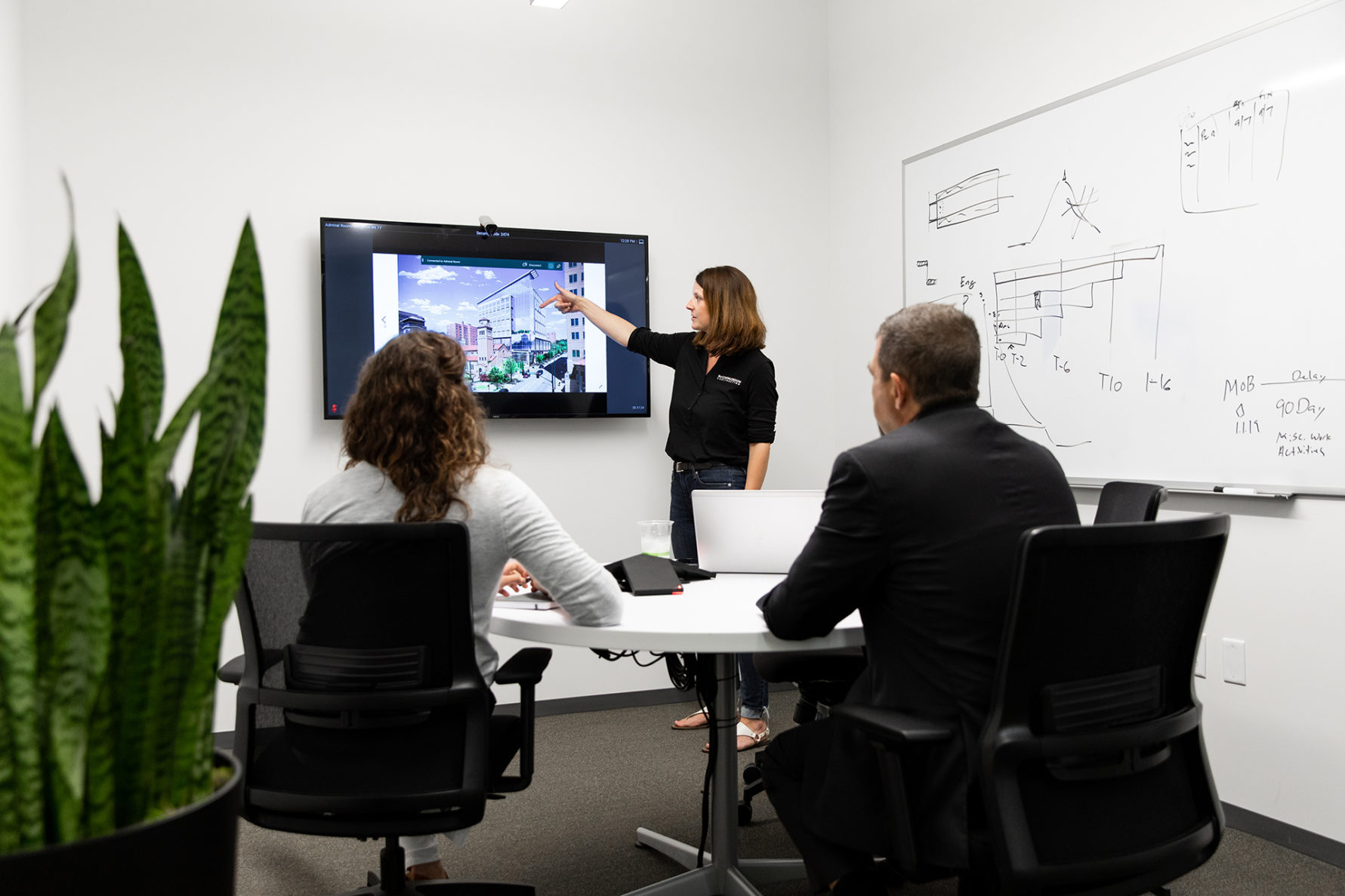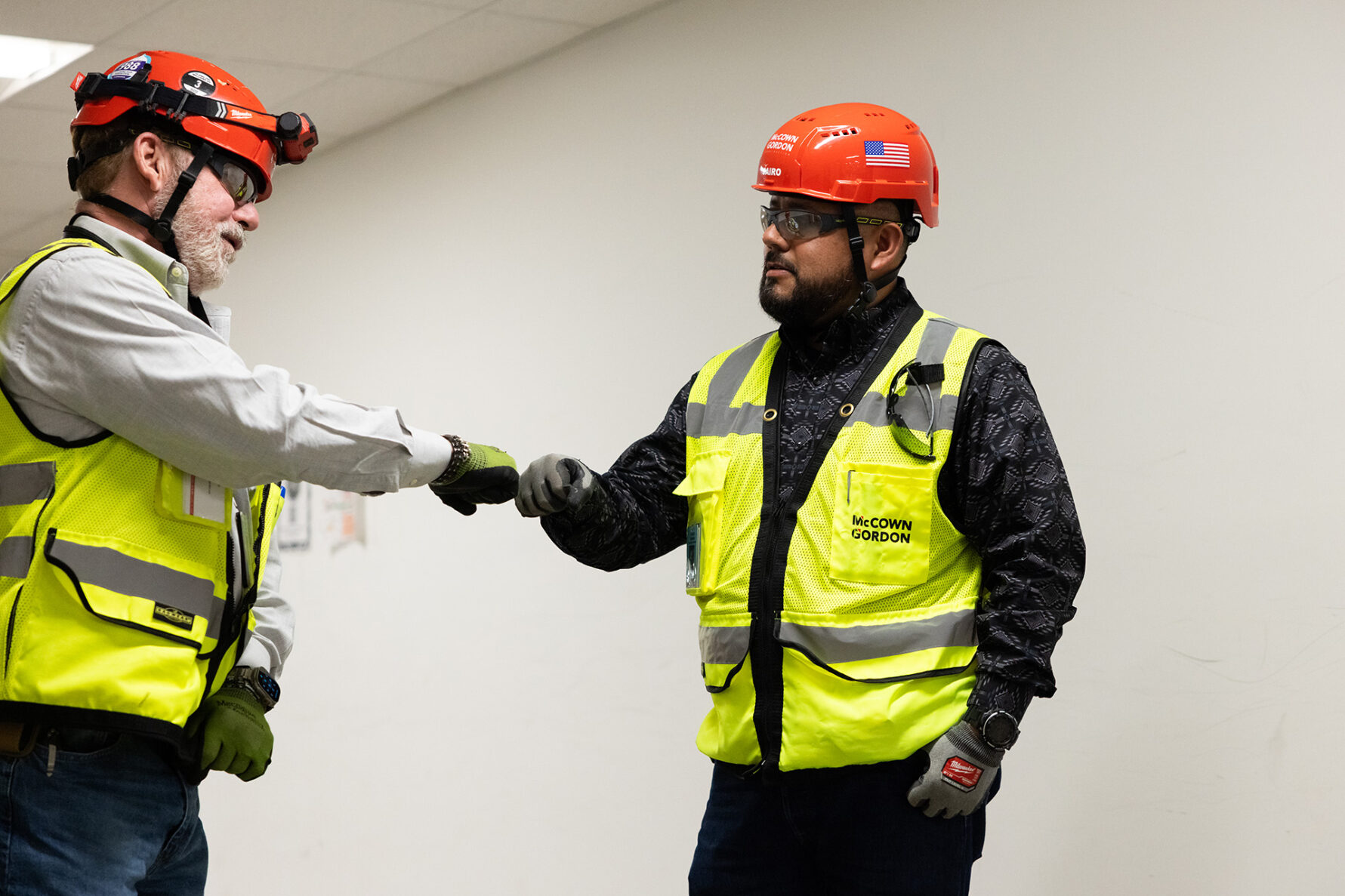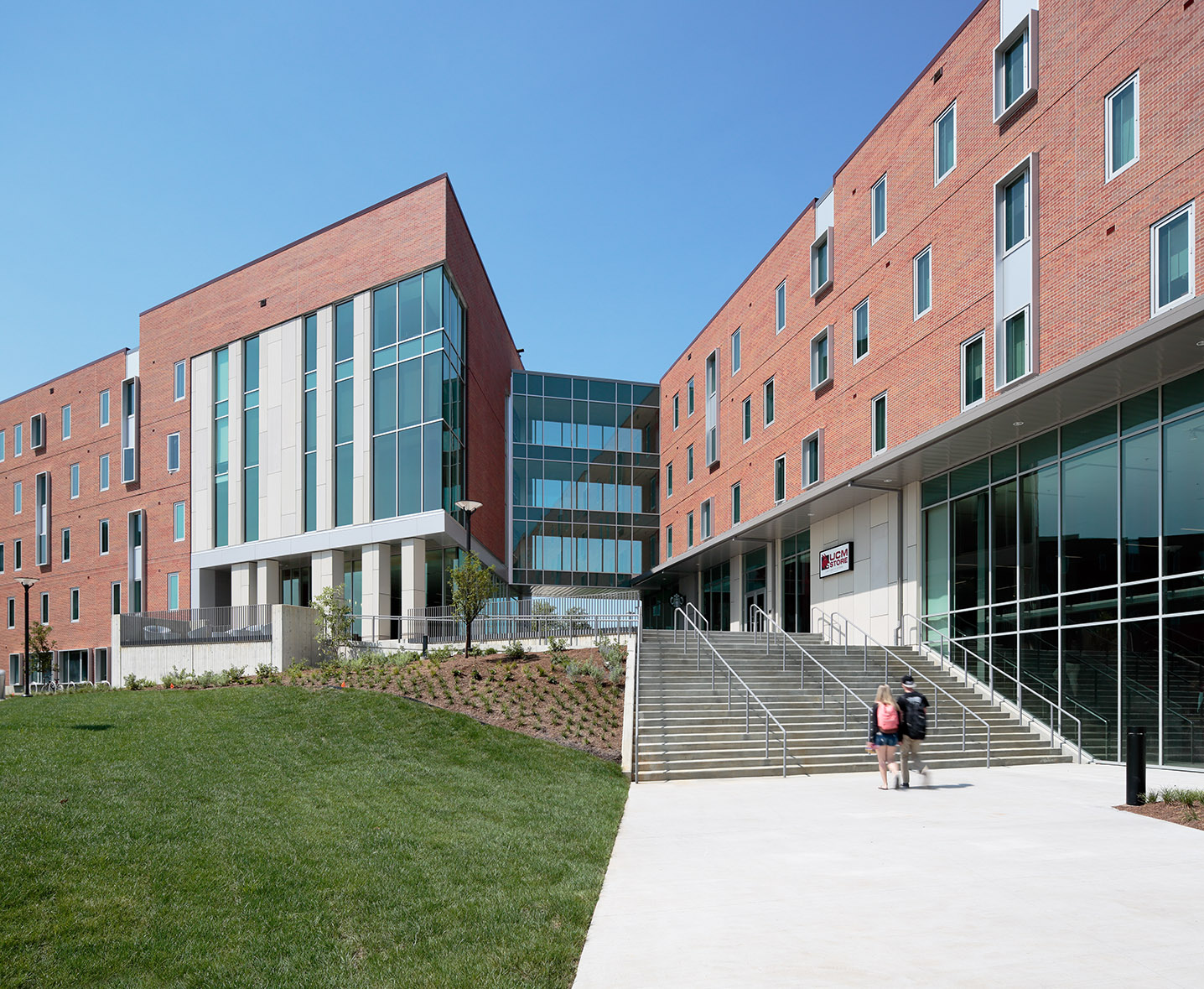Ensuring Construction Site Safety: Our Obligation to Clients, Community and Associates
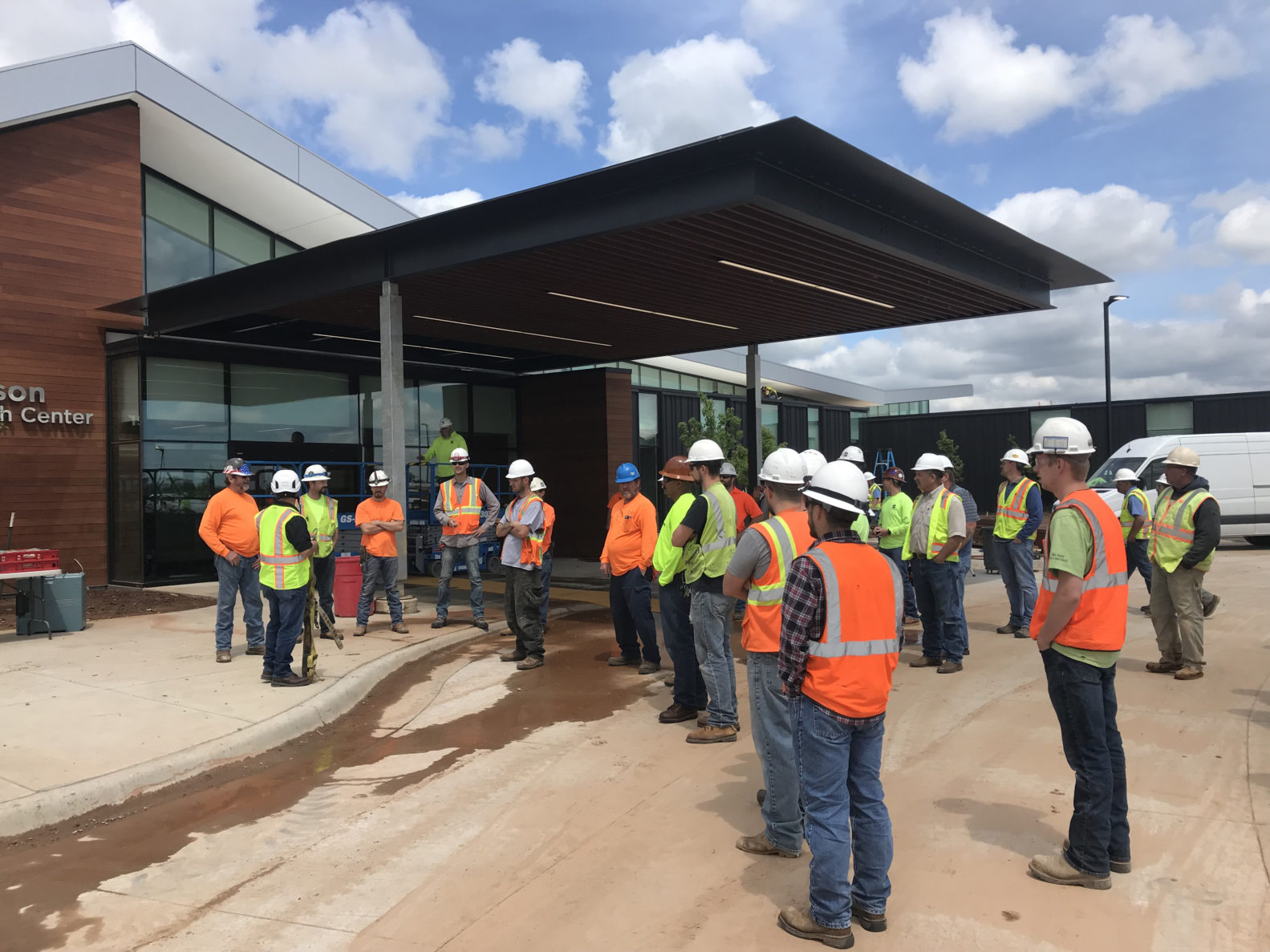
Creating an environment of support and safety has been paramount to the McCownGordon Construction culture from the beginning. We work together to build a stronger, safer industry for our associates, trade partners, clients and community.
Construction safety in the Midwest is more than a value, it’s an obligation. The drive to improve construction site safety transcends everything else.
Construction sites can be one of the most hazardous work environments, causing construction professions to regularly appear in the top 10 or 20 most dangerous jobs in America. Each and every day we’re working to change that. Those efforts resulted in McCownGordon achieving 3 million hours without a loss-time injury.
Why culture matters in construction site safety
Our decades of experience in the construction industry continually teach us the value of a strong culture when it comes to construction site safety. When associates feel valued, heard and respected, the quality of work improves. That means a safer approach to identifying and mitigating construction site hazards while delivering a project that’s on time and within budget.
Less organized teams simply do not have the same safety and quality outcomes offered by McCownGordon. Our push for strong culture, both in safety and general associate well-being, creates successful jobs on all fronts and encompasses everyone from clients to trade partners and associates.
Construction site hazards and OSHA
The Occupational Safety and Health Administration (OSHA) considers construction a high hazard industry, and in response has established a thorough set of regulations those in the industry must follow. They state:
Construction is a high hazard industry that comprises a wide range of activities involving construction, alteration, and/or repair. Construction workers engage in many activities that may expose them to serious hazards, such as falling from rooftops, unguarded machinery, being struck by heavy construction equipment, electrocutions, silica dust, and asbestos.
A Safety Team that’s always involved
Each project we undertake gets personalized attention from our Safety Team. They develop safety key progress indicators (KPIs) for each project and make recommendations for continuous improvement. Their findings also integrate into our Safety and Health Management System (SHMS), an easily accessible digital dashboard that puts vital information at our fingertips.
Using the dashboard, project teams understand safety expectations before running into issues. When we use safety KPIs as a proactive measure instead of an afterthought, projects run smoother from start to finish—they stay on budget, on schedule and free of injuries.
We believe and show that safety is paramount in all that we do. Our safety protocols ensure all who enter our projects go home the same way they entered—healthy and safe—every single time.
The importance of tracking in construction safety
It is through measurement we’re able to grow and improve. By tracking these KPIs, we gain the ability to laser focus on any potential deficiencies and to put corrective measures in place so we move forward in a positive way. We’re also able to pinpoint practices or procedures that result in improved safety so they can be implemented on all projects in relatively short time.
By tracking safety KPIs, this has allowed our project teams to see results in real time and then be able to make any necessary changes for the health and safety of our craft associates. Giving access to easy-to-read results of those measurements brings the entire project team into the conversation.
Many clients we work with have their own established KPIs. Through collaboration and continuous learning, we can integrate our own safety progress indicators into theirs (and vice versa) to track the vital information from both perspectives.
The value of streamlined Safety and Health Management Systems (SHMS)
At McCownGordon, our teams utilize a dashboard containing a collection of visual reports on safety data, both in real time and the long term to track trends. We visualize and drill down on project-specific hazards to improve overall construction site safety. Additionally, the SHMS features a tracking matrix so we can determine how our overall safety culture is advancing.
The reports and data collected in the SHMS seamlessly integrate with our construction management software. These tools put critical safety data at our fingertips with the ability to enter all data on hours worked and incidents that may occur. Every project has easy-to-read data available on one dashboard for ease of access.
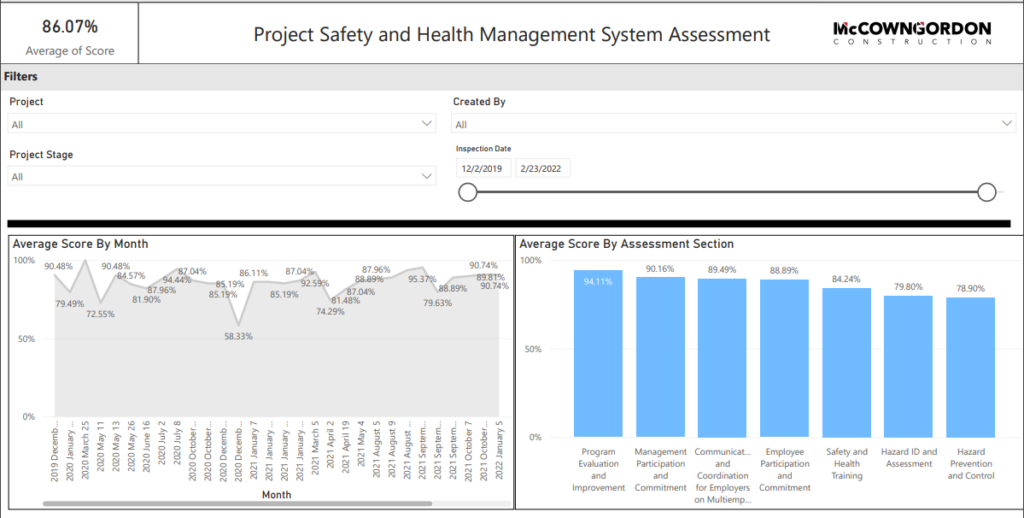
Cultivating a sense of pride in safety
At the end of the day, our one, foundational goal is getting everyone home the same way they showed up in the morning—safe and healthy.
Our associates take pride in the work they do, not just because of the value we deliver to clients or their ability to see the impact their work has on their communities’ skylines, but because they can point out that new building to their family knowing no one was injured on that jobsite.
All you have to do is compare our 3 million work hours without a loss-time injury to the industry average of 80,000 hours to see the success of our safety culture. With the culture established, our goal is to enhance it. Ultimately, we don’t want to accept any injuries on our projects. Our associates deserve a job where construction site safety is taken seriously; that’s what we deliver at McCownGordon, and that commitment will never waver.
Operational Risk Management daily work briefings
The Safety and Health Management System is just one way we tackle construction site safety. We also implemented a process for Operational Risk Management (ORM) involving everyone working on the project. In these daily task planning sessions, the team gathers around a dry erase board illustrating five core steps to ensure daily tasks are completed safely. These construction safety meetings allow for everyone to discuss their task for the day, the hazards associated and how to mitigate risk before starting the work day.
In the ORM briefings, we address training, planning and prevention. Through this process the team has increased situational awareness of what they’re facing, which is essential to reducing the potential for and the elimination of accidents. We give every associate a platform to take the lead and have their voice heard. We believe in creating dialogue and developing an environment that is not only safe, but inclusive.
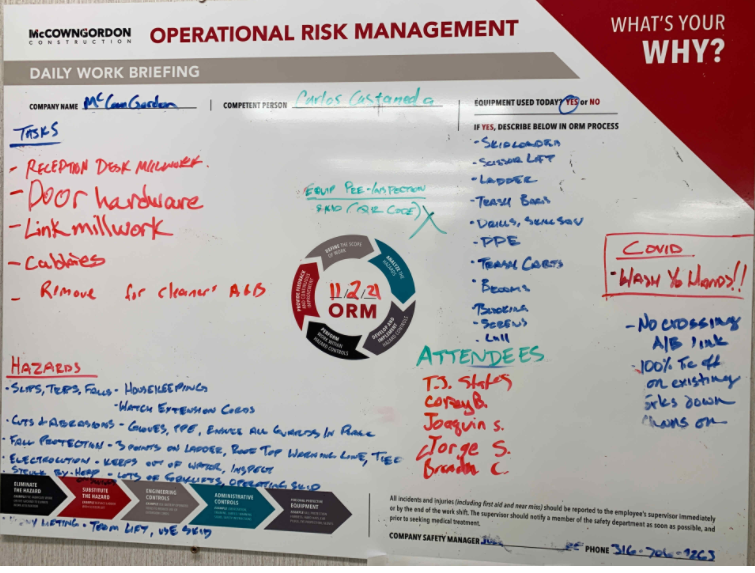
The construction industry is transforming, and McCownGordon is at the forefront. We understand that even the newest associates need to have their voices heard. Our approach to collaborative task planning is perfectly in step with our commitment to DEI, inclusion is baked in. Everyone gets an opportunity to voice their opinion and ask questions; in fact, it’s expected.
In construction, there are often a multitude of approaches to accomplish any given task. Someone who is new to the industry may have great, fresh ideas for completing a job. By making this ORM process an open dialogue, with full participation from all, these new, fresh ideas are brought to the forefront – and typically make the process safer. Some company cultures don’t put emphasis on gathering input from their newest voices, but it’s simply not how we operate.
A solid base to build on
Every good construction project should start with a strong foundation. ORM through these daily briefings establishes a foundation for the work we do each and every day. Environments and jobsites change, so it’s natural for there to be additional planning happening on the fly, but with a solid base of understanding and collaboration, those spur-of-the-moment plans are more successful and informed.
Not only do these daily briefings encompass plans to safely accomplish tasks, they ensure all proper personal protective equipment is accounted for as well. Even with projects consisting of several different crews doing various tasks, each team displays what they’re doing so everyone has awareness of the hazards associated with the total scope of work. Situational awareness is essential to construction site safety and this ORM process accounts for it.
A full circle of construction site safety
Once the ORM board is completed for the task, the team uploads it into the SMHS dashboard so they, too, can be measured. A designated Safety Team member reviews the uploaded ORM boards, creating interaction between the team and the associates on the field. This full feedback loop is more effective than older systems which relied on documents handled by the project team.
Each and every associate at McCownGordon receives training on the ORM because safety is everyone’s responsibility. Cementing this daily practice ensures our safety culture is maintained even as our company grows and works with new trade partners.
Construction site safety—always a top priority
When everyone is involved, safety improves across the board. As one of the safest construction companies in the industry, McCownGordon is proud of the positive impact our culture has on our own team as well as the outcomes for our clients.
At McCownGordon, our team maintains a customer-focused mentality, allowing us to meet or exceed even your highest expectations. Dedicated to promoting integrity, performance and relationships, it’s our people and values that truly make the difference.
Our customers aren’t simply another project; they’re an extension of our team and community. Together, we don’t just build—we bring creative visions to life. From first thought to final nail, we deliver quality work to ensure our builds stand above the rest.
We have three regional offices around the Midwest—Kansas City, Manhattan and Wichita in addition to our newest location in Dallas-Fort Worth, Texas. Call us at 888-304-4929 or use our free online quote tool to start building today.

